2009 PONTIAC TORRENT seat adjustment
[x] Cancel search: seat adjustmentPage 29 of 436
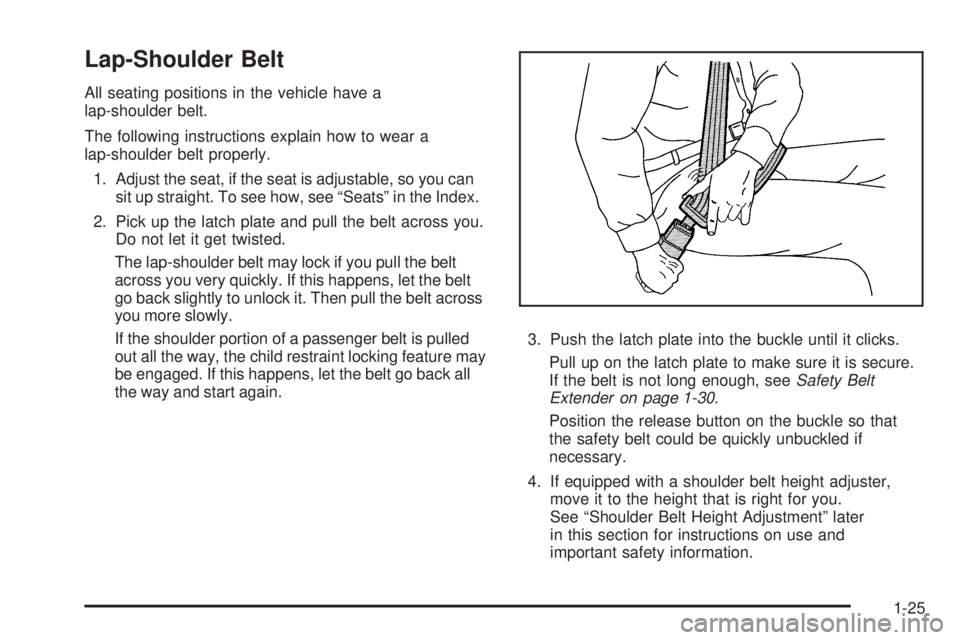
Lap-Shoulder Belt
All seating positions in the vehicle have a
lap-shoulder belt.
The following instructions explain how to wear a
lap-shoulder belt properly.
1. Adjust the seat, if the seat is adjustable, so you can
sit up straight. To see how, see “Seats” in the Index.
2. Pick up the latch plate and pull the belt across you.
Do not let it get twisted.
The lap-shoulder belt may lock if you pull the belt
across you very quickly. If this happens, let the belt
go back slightly to unlock it. Then pull the belt across
you more slowly.
If the shoulder portion of a passenger belt is pulled
out all the way, the child restraint locking feature may
be engaged. If this happens, let the belt go back all
the way and start again.3. Push the latch plate into the buckle until it clicks.
Pull up on the latch plate to make sure it is secure.
If the belt is not long enough, seeSafety Belt
Extender on page 1-30.
Position the release button on the buckle so that
the safety belt could be quickly unbuckled if
necessary.
4. If equipped with a shoulder belt height adjuster,
move it to the height that is right for you.
See “Shoulder Belt Height Adjustment” later
in this section for instructions on use and
important safety information.
1-25
Page 31 of 436
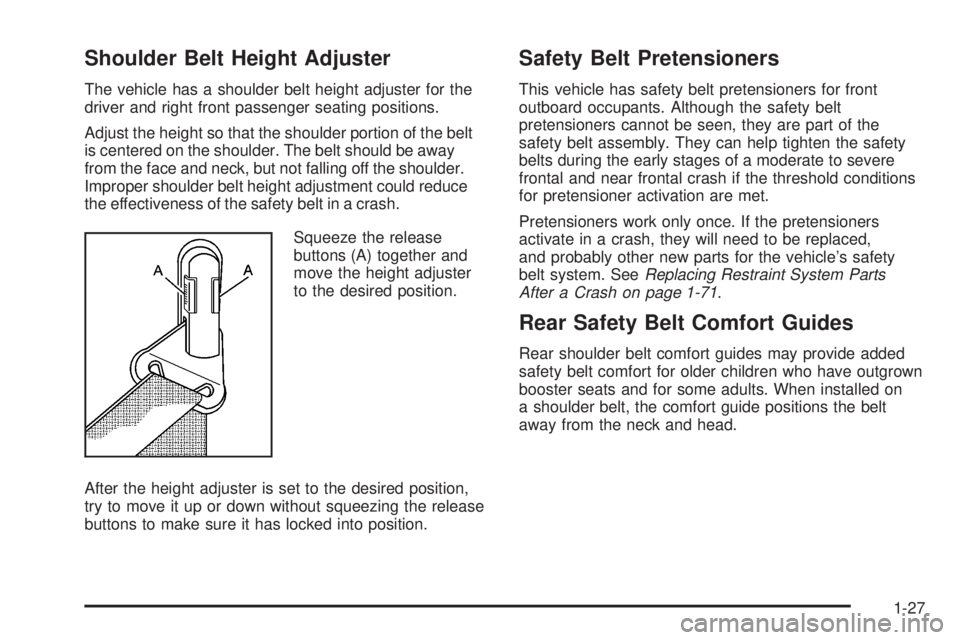
Shoulder Belt Height Adjuster
The vehicle has a shoulder belt height adjuster for the
driver and right front passenger seating positions.
Adjust the height so that the shoulder portion of the belt
is centered on the shoulder. The belt should be away
from the face and neck, but not falling off the shoulder.
Improper shoulder belt height adjustment could reduce
the effectiveness of the safety belt in a crash.
Squeeze the release
buttons (A) together and
move the height adjuster
to the desired position.
After the height adjuster is set to the desired position,
try to move it up or down without squeezing the release
buttons to make sure it has locked into position.
Safety Belt Pretensioners
This vehicle has safety belt pretensioners for front
outboard occupants. Although the safety belt
pretensioners cannot be seen, they are part of the
safety belt assembly. They can help tighten the safety
belts during the early stages of a moderate to severe
frontal and near frontal crash if the threshold conditions
for pretensioner activation are met.
Pretensioners work only once. If the pretensioners
activate in a crash, they will need to be replaced,
and probably other new parts for the vehicle’s safety
belt system. SeeReplacing Restraint System Parts
After a Crash on page 1-71.
Rear Safety Belt Comfort Guides
Rear shoulder belt comfort guides may provide added
safety belt comfort for older children who have outgrown
booster seats and for some adults. When installed on
a shoulder belt, the comfort guide positions the belt
away from the neck and head.
1-27
Page 129 of 436

The main components of the instrument panel are the following:
A.Outlet Adjustment on page 3-23.
B.Turn Signal/Multifunction Lever on page 3-7.
C.Instrument Panel Cluster on page 3-25.
D.Windshield Wipers on page 3-8.
E.DIC Operation and Displays on page 3-42.
F.Hazard Warning Flashers on page 3-6.
G.Passenger Airbag Status Indicator on page 3-29.
H.Rear Window Wiper/Washer on page 3-10.
Fog Lamps on page 3-14.
I.Outside Power Mirrors on page 2-37.
J.Instrument Panel Brightness on page 3-15.K.Cruise Control on page 3-10.
L.Tilt Wheel on page 3-6.
M.Horn on page 3-6.
N.Audio Steering Wheel Controls on page 3-118.
O.Audio System(s) on page 3-64.
P. Shift Lever. SeeShifting Into Park on page 2-32.
Q.Traction Control System (TCS) on page 4-7.
R.Power Windows on page 2-15.
S.Climate Control System on page 3-19.Heated Seats
on page 1-4(If Equipped).
T.Glove Box on page 2-42.
3-5
Page 147 of 436
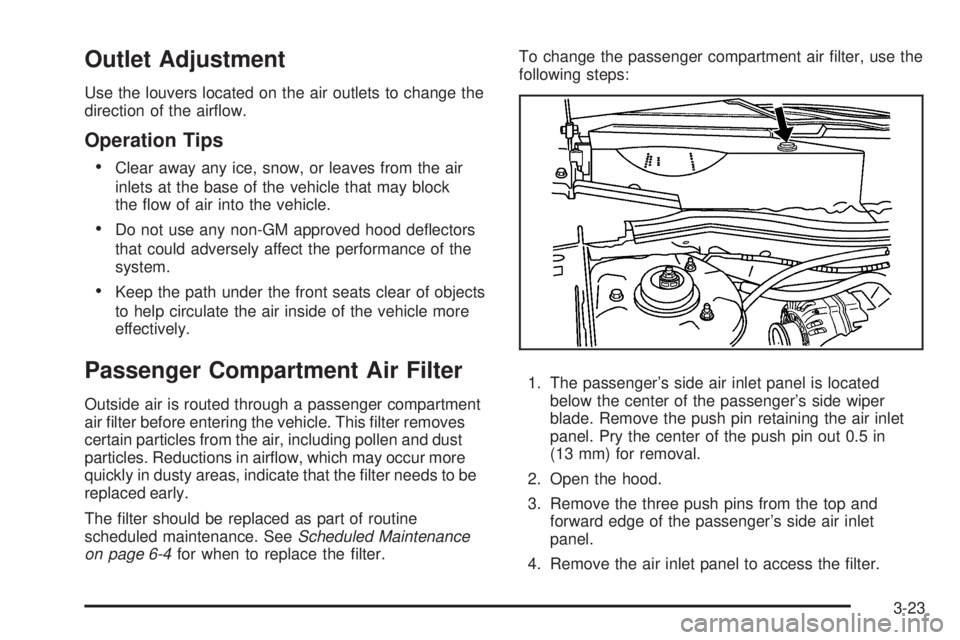
Outlet Adjustment
Use the louvers located on the air outlets to change the
direction of the air�ow.
Operation Tips
Clear away any ice, snow, or leaves from the air
inlets at the base of the vehicle that may block
the �ow of air into the vehicle.
Do not use any non-GM approved hood de�ectors
that could adversely affect the performance of the
system.
Keep the path under the front seats clear of objects
to help circulate the air inside of the vehicle more
effectively.
Passenger Compartment Air Filter
Outside air is routed through a passenger compartment
air �lter before entering the vehicle. This �lter removes
certain particles from the air, including pollen and dust
particles. Reductions in air�ow, which may occur more
quickly in dusty areas, indicate that the �lter needs to be
replaced early.
The �lter should be replaced as part of routine
scheduled maintenance. SeeScheduled Maintenance
on page 6-4for when to replace the �lter.To change the passenger compartment air �lter, use the
following steps:
1. The passenger’s side air inlet panel is located
below the center of the passenger’s side wiper
blade. Remove the push pin retaining the air inlet
panel. Pry the center of the push pin out 0.5 in
(13 mm) for removal.
2. Open the hood.
3. Remove the three push pins from the top and
forward edge of the passenger’s side air inlet
panel.
4. Remove the air inlet panel to access the �lter.
3-23
Page 210 of 436
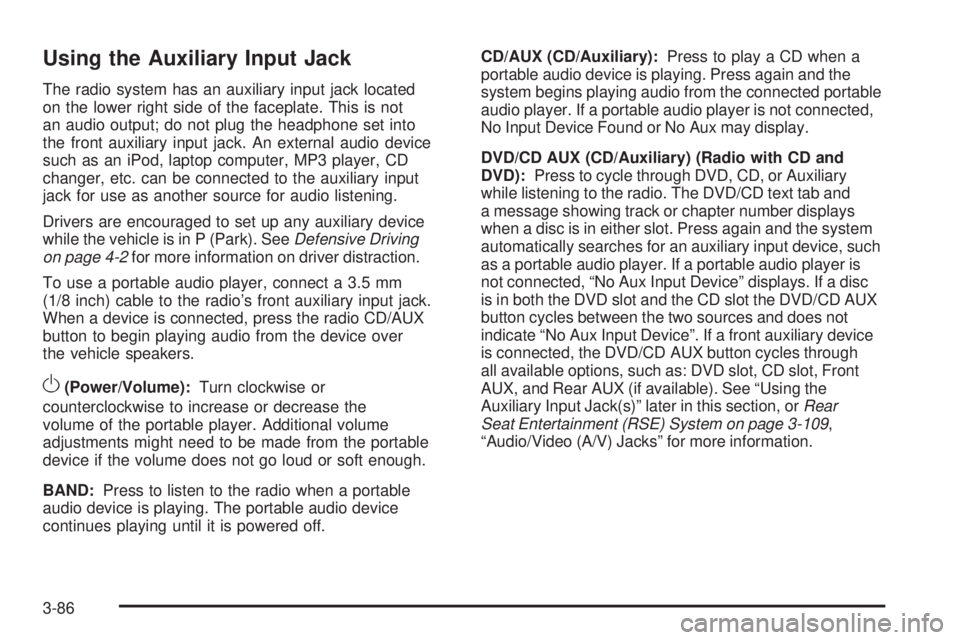
Using the Auxiliary Input Jack
The radio system has an auxiliary input jack located
on the lower right side of the faceplate. This is not
an audio output; do not plug the headphone set into
the front auxiliary input jack. An external audio device
such as an iPod, laptop computer, MP3 player, CD
changer, etc. can be connected to the auxiliary input
jack for use as another source for audio listening.
Drivers are encouraged to set up any auxiliary device
while the vehicle is in P (Park). SeeDefensive Driving
on page 4-2for more information on driver distraction.
To use a portable audio player, connect a 3.5 mm
(1/8 inch) cable to the radio’s front auxiliary input jack.
When a device is connected, press the radio CD/AUX
button to begin playing audio from the device over
the vehicle speakers.
O(Power/Volume):Turn clockwise or
counterclockwise to increase or decrease the
volume of the portable player. Additional volume
adjustments might need to be made from the portable
device if the volume does not go loud or soft enough.
BAND:Press to listen to the radio when a portable
audio device is playing. The portable audio device
continues playing until it is powered off.CD/AUX (CD/Auxiliary):Press to play a CD when a
portable audio device is playing. Press again and the
system begins playing audio from the connected portable
audio player. If a portable audio player is not connected,
No Input Device Found or No Aux may display.
DVD/CD AUX (CD/Auxiliary) (Radio with CD and
DVD):Press to cycle through DVD, CD, or Auxiliary
while listening to the radio. The DVD/CD text tab and
a message showing track or chapter number displays
when a disc is in either slot. Press again and the system
automatically searches for an auxiliary input device, such
as a portable audio player. If a portable audio player is
not connected, “No Aux Input Device” displays. If a disc
is in both the DVD slot and the CD slot the DVD/CD AUX
button cycles between the two sources and does not
indicate “No Aux Input Device”. If a front auxiliary device
is connected, the DVD/CD AUX button cycles through
all available options, such as: DVD slot, CD slot, Front
AUX, and Rear AUX (if available). See “Using the
Auxiliary Input Jack(s)” later in this section, orRear
Seat Entertainment (RSE) System on page 3-109,
“Audio/Video (A/V) Jacks” for more information.
3-86
Page 425 of 436
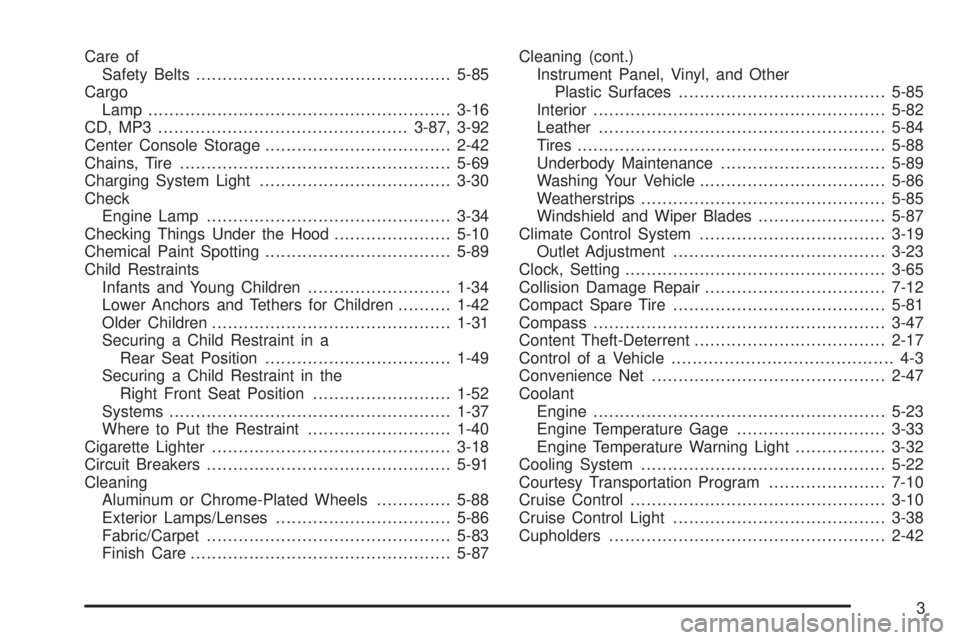
Care of
Safety Belts................................................5-85
Cargo
Lamp .........................................................3-16
CD, MP3 ...............................................3-87, 3-92
Center Console Storage...................................2-42
Chains, Tire...................................................5-69
Charging System Light....................................3-30
Check
Engine Lamp..............................................3-34
Checking Things Under the Hood......................5-10
Chemical Paint Spotting...................................5-89
Child Restraints
Infants and Young Children...........................1-34
Lower Anchors and Tethers for Children..........1-42
Older Children.............................................1-31
Securing a Child Restraint in a
Rear Seat Position...................................1-49
Securing a Child Restraint in the
Right Front Seat Position..........................1-52
Systems.....................................................1-37
Where to Put the Restraint...........................1-40
Cigarette Lighter.............................................3-18
Circuit Breakers..............................................5-91
Cleaning
Aluminum or Chrome-Plated Wheels..............5-88
Exterior Lamps/Lenses.................................5-86
Fabric/Carpet..............................................5-83
Finish Care.................................................5-87Cleaning (cont.)
Instrument Panel, Vinyl, and Other
Plastic Surfaces.......................................5-85
Interior.......................................................5-82
Leather......................................................5-84
Tires..........................................................5-88
Underbody Maintenance...............................5-89
Washing Your Vehicle...................................5-86
Weatherstrips..............................................5-85
Windshield and Wiper Blades........................5-87
Climate Control System...................................3-19
Outlet Adjustment
........................................3-23
Clock, Setting.................................................3-65
Collision Damage Repair..................................7-12
Compact Spare Tire........................................5-81
Compass.......................................................3-47
Content Theft-Deterrent....................................2-17
Control of a Vehicle.......................................... 4-3
Convenience Net............................................2-47
Coolant
Engine.......................................................5-23
Engine Temperature Gage............................3-33
Engine Temperature Warning Light.................3-32
Cooling System..............................................5-22
Courtesy Transportation Program......................7-10
Cruise Control................................................3-10
Cruise Control Light........................................3-38
Cupholders....................................................2-42
3
Page 428 of 436

Fuel............................................................... 5-5
Additives...................................................... 5-6
California Fuel.............................................. 5-6
Economy Driving........................................... 4-2
Filling a Portable Fuel Container....................5-10
Filling the Tank............................................. 5-8
Fuels in Foreign Countries.............................. 5-7
Gage .........................................................3-41
Gasoline Octane........................................... 5-5
Gasoline Speci�cations.................................. 5-6
Low Fuel Warning Light................................3-41
Fuses
Engine Compartment Fuse Block...................5-93
Fuses and Circuit Breakers...........................5-91
Instrument Panel Fuse Block.........................5-92
Windshield Wiper.........................................5-91
G
Gage
Speedometer..............................................3-26
Tachometer.................................................3-26
Gages
Engine Coolant Temperature.........................3-33
Fuel..........................................................3-41
Trip Odometer.............................................3-26Gasoline
Octane........................................................ 5-5
Speci�cations............................................... 5-6
Gate Ajar Light...............................................3-40
Glove Box.....................................................2-42
GM Mobility Reimbursement Program.................. 7-7
H
Halogen Bulbs................................................5-43
Hazard Warning Flashers................................... 3-6
Head Restraints............................................... 1-7
Headlamp
Aiming .......................................................5-43
Headlamps....................................................3-13
Bulb Replacement.......................................5-43
Daytime Running Lamps (DRL).....................3-13
Flash-to-Pass............................................... 3-8
Headlamps, Front Turn Signal, Sidemarker,
and Parking Lamps..................................5-44
High/Low Beam Changer................................ 3-8
On Reminder..............................................3-13
Range Adjustment......................................... 1-7
Heated Seats................................................... 1-4
Heater...........................................................3-19
Engine Coolant...........................................2-23
6
Page 431 of 436
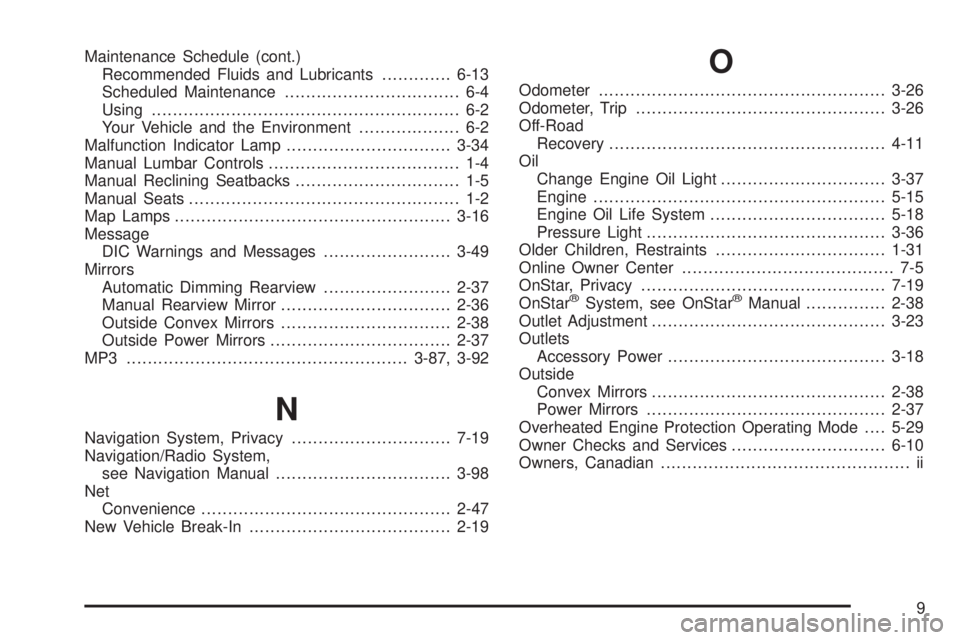
Maintenance Schedule (cont.)
Recommended Fluids and Lubricants.............6-13
Scheduled Maintenance................................. 6-4
Using.......................................................... 6-2
Your Vehicle and the Environment................... 6-2
Malfunction Indicator Lamp...............................3-34
Manual Lumbar Controls.................................... 1-4
Manual Reclining Seatbacks............................... 1-5
Manual Seats................................................... 1-2
Map Lamps ....................................................3-16
Message
DIC Warnings and Messages........................3-49
Mirrors
Automatic Dimming Rearview........................2-37
Manual Rearview Mirror................................2-36
Outside Convex Mirrors................................2-38
Outside Power Mirrors..................................2-37
MP3 .....................................................3-87, 3-92
N
Navigation System, Privacy..............................7-19
Navigation/Radio System,
see Navigation Manual.................................3-98
Net
Convenience...............................................2-47
New Vehicle Break-In......................................2-19
O
Odometer......................................................3-26
Odometer, Trip...............................................3-26
Off-Road
Recovery....................................................4-11
Oil
Change Engine Oil Light...............................3-37
Engine.......................................................5-15
Engine Oil Life System.................................5-18
Pressure Light.............................................3-36
Older Children, Restraints................................1-31
Online Owner Center........................................ 7-5
OnStar, Privacy..............................................7-19
OnStar
®System, see OnStar®Manual...............2-38
Outlet Adjustment............................................3-23
Outlets
Accessory Power.........................................3-18
Outside
Convex Mirrors............................................2-38
Power Mirrors.............................................2-37
Overheated Engine Protection Operating Mode....5-29
Owner Checks and Services.............................6-10
Owners, Canadian............................................... ii
9